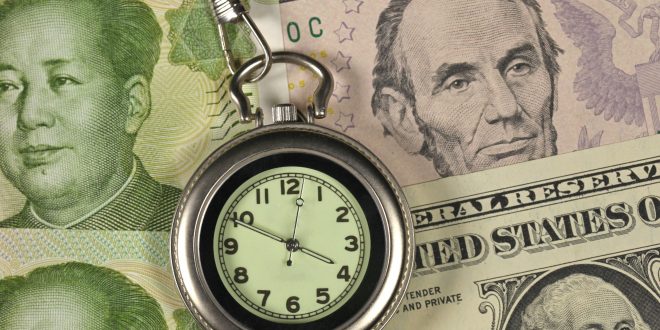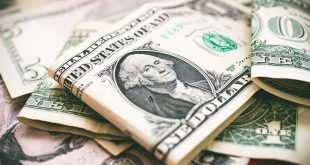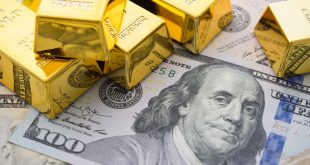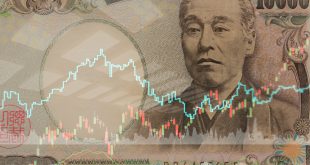On Friday, the dollar headed for the most extended period of weekly losses in nearly three years as traders reinforced expectations that the Federal Reserve is about to end the cycle of raising interest rates after indications that inflation may subside.
Thursday’s data showed US wholesale prices, which are measured by the producer price index, fell by the most in nearly three years last month, a day after inflation data indicated a moderation in consumer prices.
The dollar index, which tracks the greenback’s performance against six other currencies, fell to nearly a one-year low of 100.78 points.
It settled in the latest transactions at 101.0 points, and is heading for a weekly decline of more than one percent, the largest decline since January. This would mark the fifth straight week of losses, the longest losing streak since July 2020.
The pound rose to a ten-month high of 1.2545 against the dollar earlier on Friday and was last down 0.3 percent at $1.2492. It fell 0.3 percent to 88.48 pence against the euro.
Financial markets believe by 69 percent that the Federal Reserve will raise interest rates by 25 basis points next month, despite expectations that a series of cuts will occur from July until the end of the year, bringing interest rates to 4.3 percent in December, compared to between 4.75 and 5 percent now. .
In an interview on Thursday, Atlanta Federal Reserve Bank President Rafael Bostick told Reuters that another 25 basis point increase would allow the Fed to end the rate hike cycle with some confidence that inflation will return to its 2 percent target.
Meanwhile, an unexpected rise in Chinese exports and a strong March employment report in Australia led the Australian dollar to a 1.5% gain this week. It was last down 0.1 percent at 0.6775 against the dollar.
The New Zealand dollar fell 0.3% to $0.6281, after jumping 1.3% on Thursday.
The Japanese yen settled at 132.59 against the dollar, while the yuan outside China rose 0.3 percent to 6.8515 against the dollar.
Europe
European stocks hit their highest levels in more than a year on Friday, gaining for the fourth consecutive week, supported by positive results from large US banks and hopes for an end to the rate hike cycle in the United States.
The pan-European STOXX 600 closed up 0.6% on Friday, after hitting its highest level since February 2022 earlier in the session. The index rose 1.7 percent during the week, its longest streak of gains this year so far.
The Stoxx 50 blue-chip index also rose 0.6 percent, hitting a 22-year high.
The banking sector was the biggest gainer on the STOXX 600 on Friday, as the sector’s sub-index jumped 3 percent to its highest level in a month, after strong first-quarter earnings for large banks in the United States.
The real estate sector index rose 1.8 percent.
Oil
Oil prices rose on Friday, gaining for the fourth consecutive week, after the International Energy Agency said that global demand would rise to a new record this year, supported by China’s consumption recovery.
The agency also warned that the large production cuts announced by the producing countries in the OPEC + alliance, consisting of the Organization of the Petroleum Exporting Countries (OPEC) and other producers led by Russia, may increase oil supply shortages and harm consumers.
Brent crude futures rose 22 cents, or 0.3 percent, to settle at $86.31 a barrel. US West Texas Intermediate crude futures were at $82.52 a barrel, up 36 cents, or 0.4 percent.
The two benchmarks recorded gains for the fourth week in a row, in light of calming fears of the banking crisis that occurred last month and the sudden decision to increase production cuts taken last week by the OPEC + alliance.
The International Energy Agency said in its monthly report on Friday that global oil demand is set to rise by 2 million barrels per day (bpd) in 2023 to a record 101.9 million bpd, mostly driven by strong Chinese consumption after the lifting of COVID-19 restrictions.
The agency added that the demand for aviation fuel represents 57 percent of the increase in demand in 2023.
But on Thursday, OPEC pointed to the risks of lower oil demand in the summer, partly due to a production cut of 1.16 million barrels per day.
The International Energy Agency said in its monthly report that the OPEC+ decision could harm consumers and the global economic recovery.
“Consumers facing inflation in the prices of basic materials will now have to stretch their budgets further,” the agency said in the report.
“This strongly impacts economic recovery and growth,” the agency added.
The agency stated that it expects a decrease in global oil supply by 400,000 barrels per day by the end of the year, noting an expected increase in production of one million barrels per day from outside OPEC +, starting in March, compared to 1.4 million barrels per day that the producing countries will reduce in the group.
The dollar index is currently at its lowest level in nearly a year, after the release of consumer and producer price data in the United States this week. This reinforced expectations that the Federal Reserve (the US central bank) is nearing the end of its interest-raising cycle.
But the US currency rose on Friday, which makes oil denominated in the US currency more expensive for investors than holders of other currencies and thus affects demand.
Gold
Gold prices fell sharply on Friday, after hitting their highest levels in more than a year in the previous session, as the dollar rose and after a Federal Reserve official indicated the need to raise interest rates again.
Spot gold fell 2.1 percent to $1,996.09 an ounce by 12:03 EST on Friday. US gold futures fell 2.2 percent to $2,009.80.
The dollar index rebounded from its lowest level in a year and Treasury yields rose after a senior US central official warned of the need for the bank to continue raising interest rates to curb inflation.
Gold competes with the dollar as a safe haven amid economic or political turmoil, while the rise in the US currency leads to a decline in demand for the precious metal from buyers holding other currencies.
Daniel Pavilonis, chief market strategist at RJO Futures, said the metals market is likely to decline ahead of the US Federal Reserve’s interest rate decision in May, with expectations of a 25 basis point hike.
“Prices will stabilize near the level of approximately $2,000,” he added.
However, analysts say that the prospects for the precious metal remain positive, after its significant rise in the past two sessions, amid growing fears of a recession that may push the US central bank to end the rate-raising cycle.
As for other precious metals, spot silver fell 2.1 percent to $25.25 an ounce, after hitting a one-year high of $26.07 earlier in the session and heading towards recording gains for the fifth consecutive week.
Platinum fell 0.7% to $1,040.07, while palladium rose 0.9% to $1,512.88, and the two metals are also on track for weekly gains.
Wall Street
Wall Street closed lower on Friday after a raft of mixed economic reports seemed to confirm the Federal Reserve’s intention to raise interest rates again, dampening investor enthusiasm after major US banks kicked off the first-quarter earnings season.
The three main stock indices fell at the close, but recorded weekly gains thanks to their strong rise on Thursday.
Citigroup, JPMorgan and Wells Fargo reported first-quarter earnings, benefiting from higher interest rates and easing concerns about stress on the banking system.
The banking sector index jumped on the Standard & Poor’s 500, while JPMorgan stock recorded its highest percentage gain in one day since November 9, 2020.
 Noor Trends News, Technical Analysis, Educational Tools and Recommendations
Noor Trends News, Technical Analysis, Educational Tools and Recommendations





